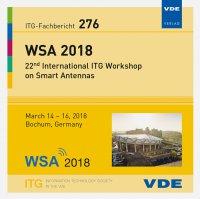Enabling Flexibility of Traffic Split Function in LTE-WiFi Aggregation Networks Through SDN
Conference: WSA 2018 - 22nd International ITG Workshop on Smart Antennas
03/14/2018 - 03/16/2018 at Bochum, Deutschland
Proceedings: WSA 2018
Pages: 8Language: englishTyp: PDF
Personal VDE Members are entitled to a 10% discount on this title
Authors:
Bayhan, Suzan; Zubow, Anatolij (Telecommunication Networks Group (TKN), Technische Universität Berlin, Germany)
Abstract:
Unlicensed spectrum is very appealing for LTE operators to expand their capacity cost-effectively. Hence, they have recently been exploring various capacity-expansion approaches using unlicensed spectrum. One option, known as LTE-WiFi aggregation (LWA), lets an LTE eNB to deliver some of its traffic through the carrier WiFi APs so that an LTE user can get its downlink traffic from both interfaces. However, LWA requires careful splitting of the traffic between LTE and WiFi resources to avoid one link becoming congested or to ensure good load balance among the colocated network nodes, e.g., eNBs and WiFi APs. Currently, the eNB is in charge of deciding how to split the traffic. However, due to its local knowledge, the split may not be optimal. Instead, we take benefits of Software-Defined Networking (SDN) by decoupling the control and data forwarding plane, where a centralized entity, traffic split function controller (TSFC), using its broader knowledge can allocate resources more efficiently. We envision that a dumb datapath element (the TSF) splits flows/packets between ports, i.e., eNB and AP(s), as defined by a remote control process, i.e. the TSFC. However, it is unclear where this centralized entity should be located in the network hierarchy, e.g., at each eNB or deep in the core network or even in the cloud, due to several opposing forces. Centralization at the higher layers in the network hierarchy brings more global knowledge at the expense of increased delay and control message overhead. In this paper, we first list the required new interfaces between network elements for the envisioned new LWA architecture and next present a simple model to decide on the TSFC placement capturing various dynamics of the user, its traffic, and radio links.


